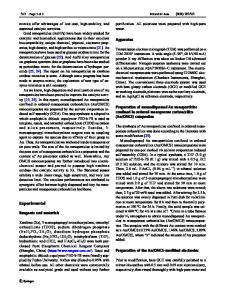Selective Ordered Mesoporous Silica Adsorbents
- PDF / 81,968 Bytes
- 7 Pages / 612 x 792 pts (letter) Page_size
- 85 Downloads / 349 Views
L8.13.1
Selective Ordered Mesoporous Silica Adsorbents Koon Fung Lam, Ka Yee Ho, King Lun Yeung† and Gordon McKay Department of Chemical Engineering, the Hong Kong University of Science and Technology, Clear Water Bay, Kowloon, Hong Kong SAR, P. R. China
ABSTRACT Ordered mesoporous silica (OMS) adsorbents were prepared by grafting amino, carboxylic and thiolcontaining functional groups onto MCM-41 for the selective removal of dye and metal pollutants from wastewater. The amino containing OMS-NH2 adsorbent has a large adsorption capacity and a strong affinity for the Acid blue 25. It can selectively remove Acid blue 25 from a mixture of dyes (i.e., Acid blue 25 and Methylene blue). The OMS-COOH is a good adsorbent for Methylene blue displaying excellent adsorption capacity and selectivity for the dye. The chemically modified OMS adsorbents were also tested for the selective removal and recovery of metals (i.e., lead and copper). The OMS-SH adsorbent can selectively remove lead from solutions containing Pb2+ and Cu2+ ions, whereas the OMSNH2 selectively adsorbed a large quantity of copper. The selectivity of the adsorbents for lead and copper is strongly influenced by pH. Indeed, by simply adjusting the pH, OMS-NH2 can adsorb mainly lead or copper from a mixture containing both metals.
INTRODUCTION The concept of ‘supra-molecular templating’ has enabled the design of ordered mesoporous materials with adjustable pore sizes and structures[1]. Ordered mesoporous silica (OMS) that includes M41S, FSM, HMS and SBA belongs to an important class of molecular sieves. Their large surface area, ordered pore structure and nanometer-sized pores offer a unique environment for chemical separations[2] and reactions[3]. Chemical modifications of the OMS with metals[4], metal oxides[5] and organic moieties[1 ]are successful in tailoring the physical, chemical and catalytic properties of these materials. The main obstacles for the widespread industrial application of OMS are their cost and stability. In the manufacture of the ordered mesoporous silica, the surfactant template accounts for most of the cost. Nondestructive methods for the removal and recovery of the surfactants and the use of cheaper polymer substitutes have substantially decreased the cost of the OMS [6,7]. Better thermal and hydrothermal stability were obtained by post-synthesis treatment of the OMS with organic solvent containing metal alkoxides[8], salt solution[9] and organosilanes[10]. Most of the adsorption and transport studies on MCM-41 were conducted for gases with very few works dealing with the liquid phase system, however; the most exciting applications of OMS are for liquid phase reactions and separations. The OMS catalysts play an important role in the ‘green’ synthesis of many high-value added fine chemicals and pharmaceuticals [1]. Hata and coworkers [11] employed OMS with tailored pore structure to recover Taxol at high purity from the extraction solvent. Recovery of proteins and Fullerenes was also demonstrated using OMS [12,13]. Feng et al.[14] had
Data Loading...











